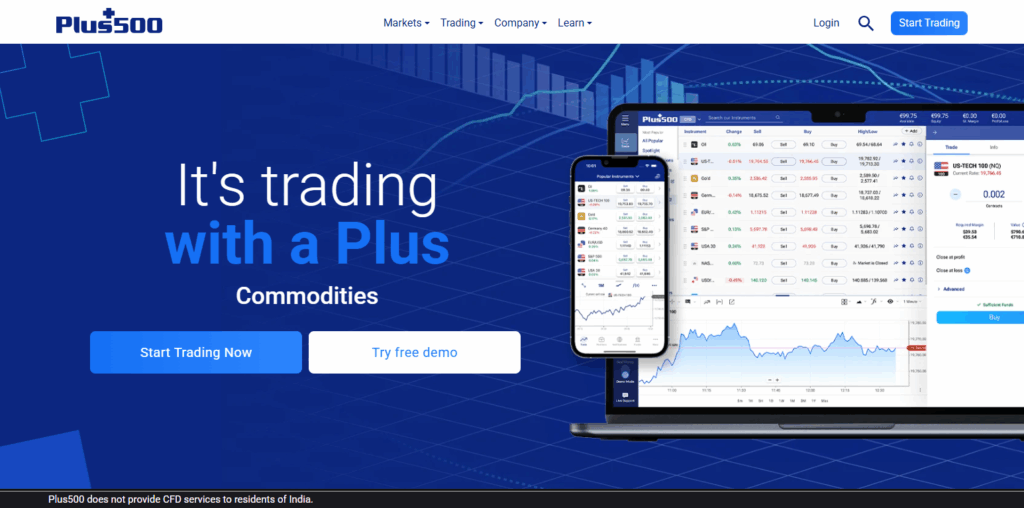eToro and Plus500 in 2025 show a defined difference between social investing and streamlined cfds. eToro appeals to social investors and long term beginners driven by community features, copy trading, and numerous assets.
Conversely, Plus500 targets active traders with a fast and simple efficient platform that offers seamless execution with a broad range of CFDs. Knowing what separates the two helps traders decide on a platform that suits their objectives and level of experience.
What Is eToro?
eToro is among the most popular and diversified online trading platforms and has a simple digital trading interface and social trading functionality. Founded in 2007, the platform has diversified cryptocurrency, stock, and ETF trading, commodity and index trading, and more – all conveniently organized on a single interface.

The platform is well-known for its Copy Trading functionality, where beginners can easily copy the trading strategies of other skilled, professional investors. Thanks to a strong infrastructure, eToro has the ability to accept new clients all around the world and is designed for people wanting transparent and community-driven investing.
What Is Plus500?
Plus500 is a worldwide multi-asset trading platform with a user-friendly interface for trading various financial products. Established in 2008, Plus500 offers accessible CFD trading on forex, stock, indices, commodities, cryptocurrency, as well as ETFs.

Plus500 has a well-established, uncomplicated trading platform, focusing on quick order execution with minimal requirements. With robust regulations in place, coupled with real-time risk management and tight spreads, Plus500 is a platform that many traders gravitate toward to achieve an uncomplicated and efficient trading experience.
eToro vs Plus500 – Feature Comparison Table
| Features | eToro | Plus500 |
|---|---|---|
| Year of foundation | 2007 | 2008 |
| Headquarters | Israel | Israel |
| Best for | Experienced traders | All levels |
| Regulations | Registered as a Money Services Business with FinCEN | FCA, CySEC, and ASIC |
| Average Fees | 0.1% – 0.2% spot | 0.2% spot |
| Number of supported cryptocurrencies | 7,000+ | 3,000+ |
| Supported payment methods | Bank transfers, wire transfers, credit/debit cards | Bank transfers, wire transfers, credit/debit cards |
| Leverage for spot trading | x30 | x5 for most assets; x30 for selected assets |
| Focused on | Global clients | Global clients |
| Native token | N/A | N/A |
| Security features | 2FA withdrawal email confirmation, API key, SSL encryption | 2FA withdrawal email confirmation, API key, SSL encryption |
Currencies Support: eToro Exchange VS. Plus500
We looked at the supported currencies at eToro comparing them to Plus500. In both platforms, several fiat currencies are accepted, including USD, EUR, GBP, among others. Specifically, at eToro you get over 35 pairs with fiat currencies, and over 7,000 crypto currencies.
Users will find major coins here, like BTC and ETH, but also several rare coins. Plus500 has a smaller offering, with 14 fiat currencies and over 3,000 cryptos. Yet, this offering is larger than most crypto exchanges.
Detailed Fees Comparison: eToro vs. Plus500
eToro and Plus500 apply different pricing models, with eToro charging a flat 1% each on opening and closing of a crypto position, and that’s added to the market price on execution. As a result, traders have an instant loss on these positions.
Conversely, Plus500 has instant buy-sell fees which are lower than their competitors, so they are a better value for people who are looking to make frequent trades.
Plus500 has no fees for bank transfer withdrawals while eToro has standard withdrawals of $5. On average, each platform has different fees which are a result of your trading volume and activity, the type of asset, and the funding method.
eToro vs. Plus500 – Fees Comparison Table
| Category | eToro | Plus500 |
|---|---|---|
| Spot trading fees | 0.1% – 0.2% | 0.2% – 0.25% |
| Instant buy-sell fees | 1% | 0.7% |
| Bank transfer (wire) fees | $5 | Free |
| Credit & debit card fees | 1.5% – 3% | No information |
| ACH fees | 1% | Free |
| NFT fees | No information | N/A |
| Margin trading fees | Depends on the asset | Depends on the asset |
| Futures fees | N/A | 0.1% |
| Staking fees | No information | N/A |
| Advanced/Pro trading fees | Depends on the tool and asset | Depends on the tool and asset |
eToro Features
Social Trading
On eToro, the users are able to connect with others as well as followers and are able to learn trading techniques from master traders and are able to access forum feeds.
Copy Trading
eToro investors can replicate the trading patterns of successful investors with Copy Trading. Beginners can achieve goals easily. Opting to follow an experienced dealer profit-wise, it establishes beneficial relationships.
Multi-Asset Trading
eToro is a one-stop shop for consumers to buy and sell a variety of assets. eToro is streamlined which benefits investors, and promotes efficiency to get access freely without limitations.
Smart Portfolios
Users of eToro get the opportunity to obtain a professionally managed and expertly assembled diversified of the highest quality among major markets without management costs and with active autonomous growth.
User-Friendly Interface
This trading platform works on all type of devices. It is a radiant platform trading on all devices and serves as a cohesive trading environment designed for every user from beginners to masters.
Stringent Legislation
eToro holds licenses from leading agencies such as FCA, CySEC, and ASIC. Assured compliance, separated clients’ funds, and operational transparency allow users to operate under the protective cover of a reputable financial institution.
Trading Tools
The platform has charts, research, risk and sentiment tools, as well as stop-loss and take-profit orders. Such tools help users make well-informed decisions and assist traders in optimizing strategies.
Wallet and Staking
eToro users can store the supported cryptocurrencies in a secured wallet and earn rewards through staking. The ability to earn passively while maintaining a stringent level of security is commendable.
Plus500 Features
User Friendly
Plud500 has developed a sleek user interface which works equally acomadyting to novice as well as advanced traders. The even streamlines tedious processes of order placements and executions.
Instrument Variety
Plus500 offers CFDs to trade across six asset categories- Forex, stocks, indices, commoditites, ETFs, and crypto. This broad range enables diversification and access across several markets, is highly customizable.
Affordable
With no hidden fees and no commission charges, traders can access numerous markets. PLUS500 is an ideal platform for traders who prefer short term, highly active trading strategies.
Risk Exposure Management
Plus500 enhances their trading features with fundamental loss control systems for traders to enable increased exposure with lower loss limits. These features are particularly effective for high volatility markets.
Trust and Feel Safe
Plus500 is held with high standards of trust trading with the FCA, CySEC, and ASIC. Users have high confidence with their data as trust is well placed with Plus500.
Profitable Trading Options
To most assets and to particular instruments, Plus500 has a x5 and x30 leverage, respectively. Traders can boost their exposure while utilizing risk controls to mitigate possible drawbacks.
Handy Trading Options
Plus500 has a web and mobile application, which allows users to trade seamlessly from any location. The trading account has fully integrated to provide users with advanced query notifications and trading execution.
Plus500
To help users get a feel of the platform and to practice market trading algorithms, Plus500 offers a demo account which users can access for as long as they want without any cost. Traders can learn platform features, test market approaches, and improve skills before switching to live trading.
Regulation
Comparing Plus500s and eToros history we see that eToro was founded in 2007 and Plus500 was founded in 2008. Both of these companies are publicly traded brokers and neither of them is a bank.
According to ForexBrokers.com, eToro was given a Trust Score of 96/99 and Plus500 received 99/99, which is still in the 90 – 99 range (highly trusted) (80 – 89 trusted, 70 – 79 average risk, 60 – 69 high risk, beyond 59 not trusted range).
In terms of supervision, eToro has 4 Tier-1 and 1 Tier-2 licenses, while Plus500 has 6 Tier-1 and 3 Tier-2. ForexBrokers.com views Tier-1 licenses as high trust and Tier-2 as trusted.
All in all, both are good in terms of supervision, Plus500 is ahead in terms of the number of licenses and Trust Score and eToro has high supervision as well.
Customer Support: eToro vs. Plus500
Both eToro and Plus500 offer different forms of customer support, but neither has phone support. Australian users are still able to use support services through digital assistance.
eToro has an extensive help center containing FAQ articles and manuals, and their ticketing system lets customers report issues, although they may take their time to reply, which can be an issue if customers are trading urgently.
Plus500 provides users with better support as they have 24/7 live chats and support through WhatsApp, plus users can receive assistance whenever they need help, which is valuable for traders.
Customer Support Comparison Table
| Customer Support | eToro | Plus500 |
|---|---|---|
| Availability | 24/7 chatbot, support staff available 24 hours Monday–Friday | 24/7 via live chat, WhatsApp, or email |
| Phone support | No | No |
| Live chat support | Yes | Yes |
| Email support | Yes | Yes |
| Self-serve materials | Yes | Yes |
eToro vs Plus500: User Experience
eToro offers a more dynamic experience centered around social trading while Plus500 prioritizes a more simplistic and efficient experience for CFD traders.
eToro’s interface is user-friendly and geared toward social trading, where users have the opportunity to engage with one another, discuss trade ideas, and follow the trades of more experienced users.
eToro’s mobile trading experience is just as seamless and user-friendly as the desktop version. eToro’s excellent educational resources, user help center and social trading feature provide users with the opportunity to continuously build and improve their trading skills.
On the contrary, Plus500’s user experience is centered around efficient and distraction-less trading. It is ideal for traders looking to quickly execute trades, and is unencumbered with unnecessary features.
Plus500’s mobile trading is instant and responsive, and their demo account allows beginners to trade with real-time quotes so they can get a feel for the markets. Plus500 is an accessible trading option for any user as they have a straightforward pricing model and offer a diverse range of CFDs.
Which Is Better: Plus500 or eToro?
Online trading platform eToro and Plus500 are both great for different reasons. Plus500 has a great simplified CFD trading experience, a great mobile app, great for advanced traders and has transparency in fees.
eToro has a great social trading community, great for beginners, and has a great mobile trading app. Plus500 and eToro both have robust 24/7 customer service and are regulated in top tier trading zones. The best trading platform comes down to whether a trader wants social trading or digital CFDs.
Final Thoughts: eToro vs Plus500 2025
In 2025, eToro and Plus500 continue being top-tier trading platforms, but they distribute their focus on different kinds of traders. eToro is the most preferred choice among new traders, long-term investors, those who appreciate social trading, and anyone who enjoys a diverse and easy-to-navigate community-oriented platform.
Its copy trading among peers, along with geared educational materials, is perfect for those looking for more hand-holding and a social interface on trading.
Plus500, on the other hand, is the ideal trading platform for those looking for cleanliness and simplicity around not just trading, but also in the trading of CFDs, along with the speed with which they can do so.
Because of their 24/7 live chat support, along with their trading app which operates smoothly, and the fact that they offer a wide range of instruments trading around CFDs, they do cater better for short and active traders more concerned with simplicity and execution promptness.
In the end, it just boils down to what you wish to achieve, as both of these are industry leading platforms. *eToro* for social and diverse trading, and Plus500 for efficient trading of CFDs with easy order execution*.
FAQ
Which platform is better in 2025 — eToro or Plus500?
It depends on your trading style. eToro is better for beginners, social trading, and multi-asset investing. Plus500 is ideal for CFD traders who want a simple, fast, and distraction-free platform.
Is eToro safer than Plus500?
Both platforms are highly regulated. eToro is regulated by bodies like FCA, CySEC, and ASIC, while Plus500 is regulated by FCA, CySEC, ASIC, and others. Safety levels are generally comparable.
Which platform has lower fees?
Fees vary by activity. eToro charges a 1% crypto fee and a $5 withdrawal fee, while Plus500 has lower instant trading fees and free bank transfer withdrawals, making it more cost-efficient for frequent traders.
Does eToro offer more assets than Plus500?
Yes. eToro provides access to stocks, ETFs, crypto, commodities, forex, and indices, plus social trading tools. Plus500 focuses mostly on CFDs, offering a wide range of leveraged trading instruments.
Which platform is better for beginners?
eToro is better for beginners due to copy trading, educational content, and a more interactive community. Plus500 is beginner-friendly too, but more oriented toward CFD traders.







